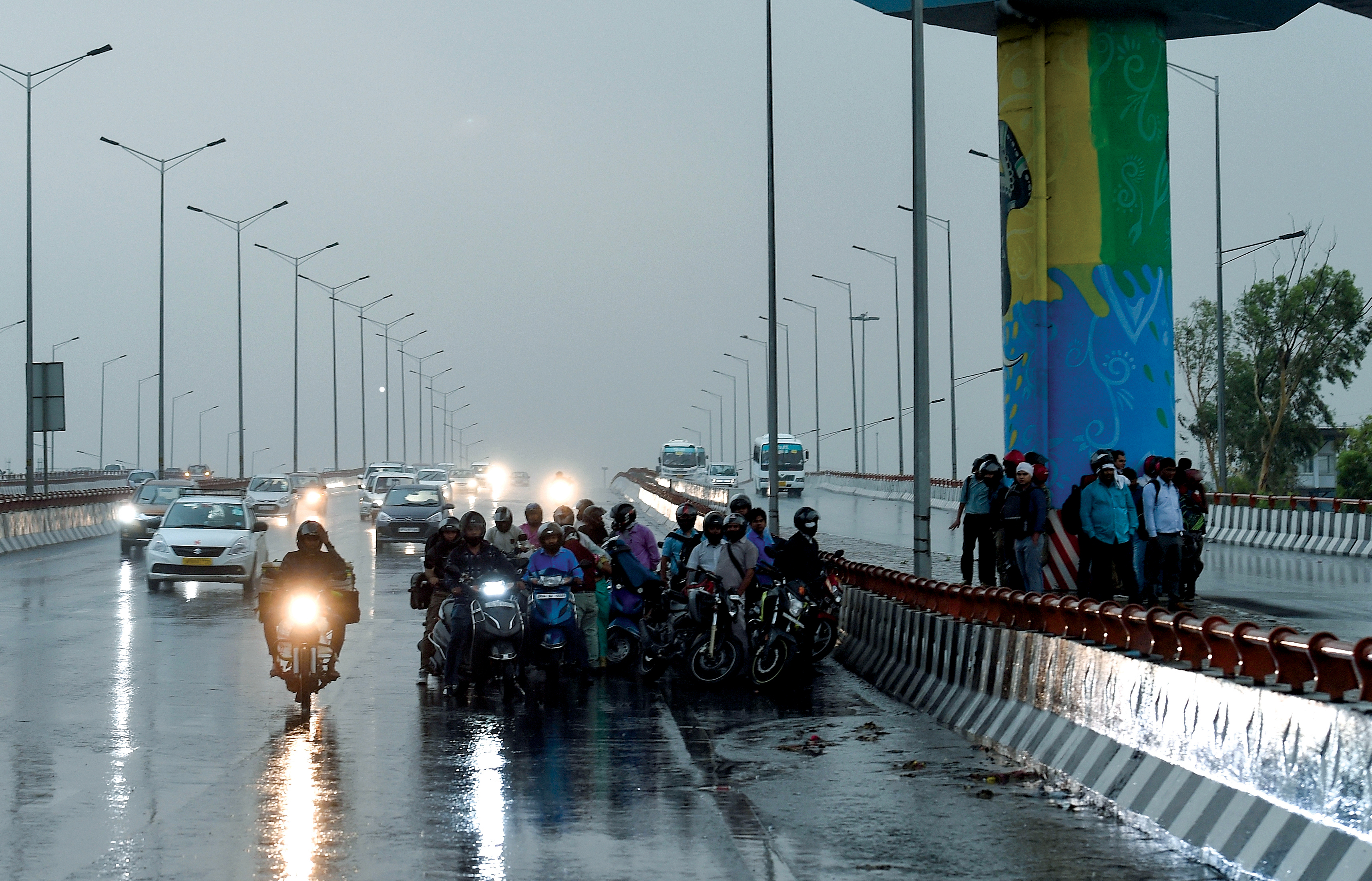
Indian motorcyclists and commuters wait under a flyover bridge during heavy rain in New Delhi on May 15, 2019. (Photo by Prakash SINGH / AFP)
It has been a torrid few weeks for Delhiites as the heat wave that came during end of May gripped the city. Walk on the streets, and one will see bikers splashing water on their seats before getting on the bikes, or girls covering their faces with a dupatta to protect themselves from the scorching sun.
According to the Indian Meteorological Department regulations, heat wave is declared in Delhi, if the temperature crosses 45 degree Celsius for two consecutive days, and when the mercury hits more than 47 degrees, the IMD declares extreme heatwave.
The IMD observed that temperatures soared above 45 degrees since May 29, till June 15th. On June 9th the maximum temperature recorded in the city was 48 degrees Celsius. This was the highest ever temperature that has ever been recorded in Delhi in the past century –the previous peak of 47.4 was recorded five years back.
Not only this, but the city received consistent temperatures of over 46-47 degrees during the second week of June, thus recording extreme heatwave. A thing to note is the fact that extreme heatwave is only recorded in areas which are close to deserts like parts of Rajasthan and Gujarat. But it was right here in the heart of the capital city, that we got to experience what life in the desert feels like.
While the city experienced strong winds at this time, it was not the kind to give Delhiites respite. The hot gushes of wind were what weather officials term as ‘loo’ – dry, dust wind that originates from the desert region of Baluchistan and enters into India and Pakistan during the summers.
This summer proved to be even hotter than 2018, which was officially the sixth hottest summer of all time, and till last week, temperatures were officially 1-2 degrees higher than last year. If we consider the historical average temperature of Delhi during this period, it has been consistently 4-5 degrees higher than normal this year.
However, since June 17, temperatures dropped. That Monday, the minimum temperature touched somewhere around 20 degrees Celsius, 4 degrees lower than normal. This happened due to a sudden gush of windy dust storms and a little rain – 20.6 mm to be precise.
The rains were caused by the Western Disturbances, according to IMD director of the Delhi zone, Kuldeep Srivastava. Western Disturbances are usually winds that bring light rainfall and storms in the pre-monsoon period. But that is not it, as we have more good news. Srivastava confirmed to Patriot that Delhi will experience more such pre-monsoon rainfall in the period till June 26, as the Western Disturbances are likely to stay.
He also said that maximum temperatures during this time will hover around the 40 degrees, and not cross the 45-degree mark. “The heat wave is officially over”, he confirmed. Now, this is something that will definitely sound like music to the ears of Delhiites who were reeling under this extreme heat.
So, the question that is on everybody’s mind right now is when the monsoons will arrive in the city. “The regular monsoons are likely to arrive in the city by the first week of July”, says Srivastava, adding that the department will confirm the date in the coming week.
However, there has been a delay in the arrival of monsoons in 2019. Srivastava says the monsoon winds were supposed to be striking Delhi by the last week of June, but has been delayed because the winds struck the Kerala coast a bit later than usual. Hence it is taking longer for the winds to arrive northwards in Delhi.
The delay was also because of the moisture in the air generated due to cyclone Vayu which prevented the winds from coming northwards, but since the atmosphere is normal it is progressing. “The winds have hit Bihar yesterday, and it indicates that it is travelling northward, and there will be rain in the coming weeks”, says Srivastava.
In the midst of all this good news, however, there is a hint of worry too, as The Weather Channel, a private weather determining organization has predicted that there is 80% chance of less than normal rainfall in Delhi in 2019. Even the pre-monsoon rain that the city has received has been lesser than usual, and this will further aggravate the water crisis situation that has struck parts of the city now.
Delhi Fire Service has initiated comprehensive fire safety inspection drive in restaurants, hotels and clubs…
Out of 40 air quality monitoring stations across the city, 14 recorded severe air quality…
Govt, however, acknowledged that air pollution is one of the triggering factors for respiratory ailments…
Rising air pollution levels in the capital, the Delhi government on Thursday undertook a comprehensive…
Parents say online classes during severe air pollution ignore the digital realities of economically weaker…
Rival leagues trigger players’ suspensions and a legal battle in Indian golf, for now